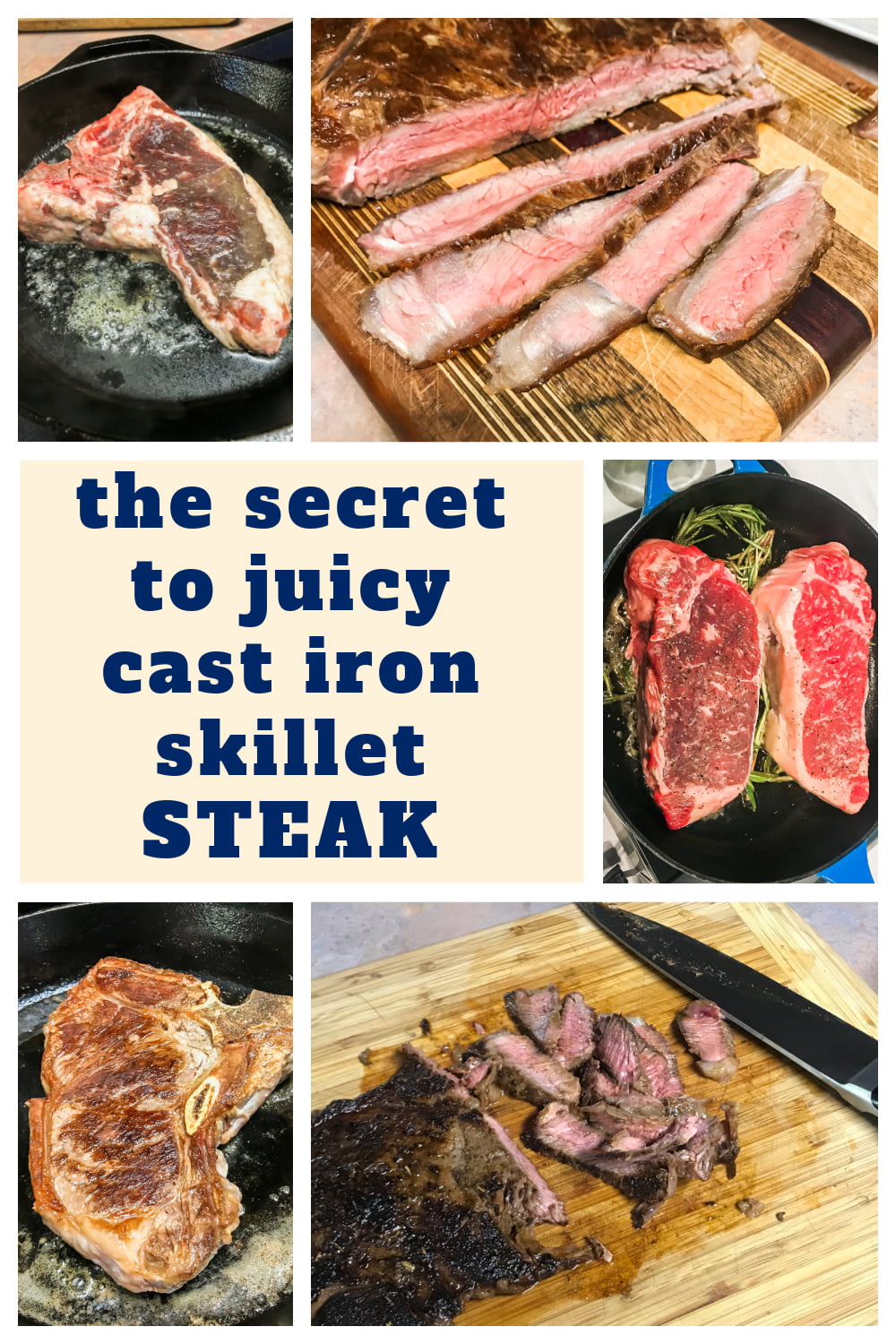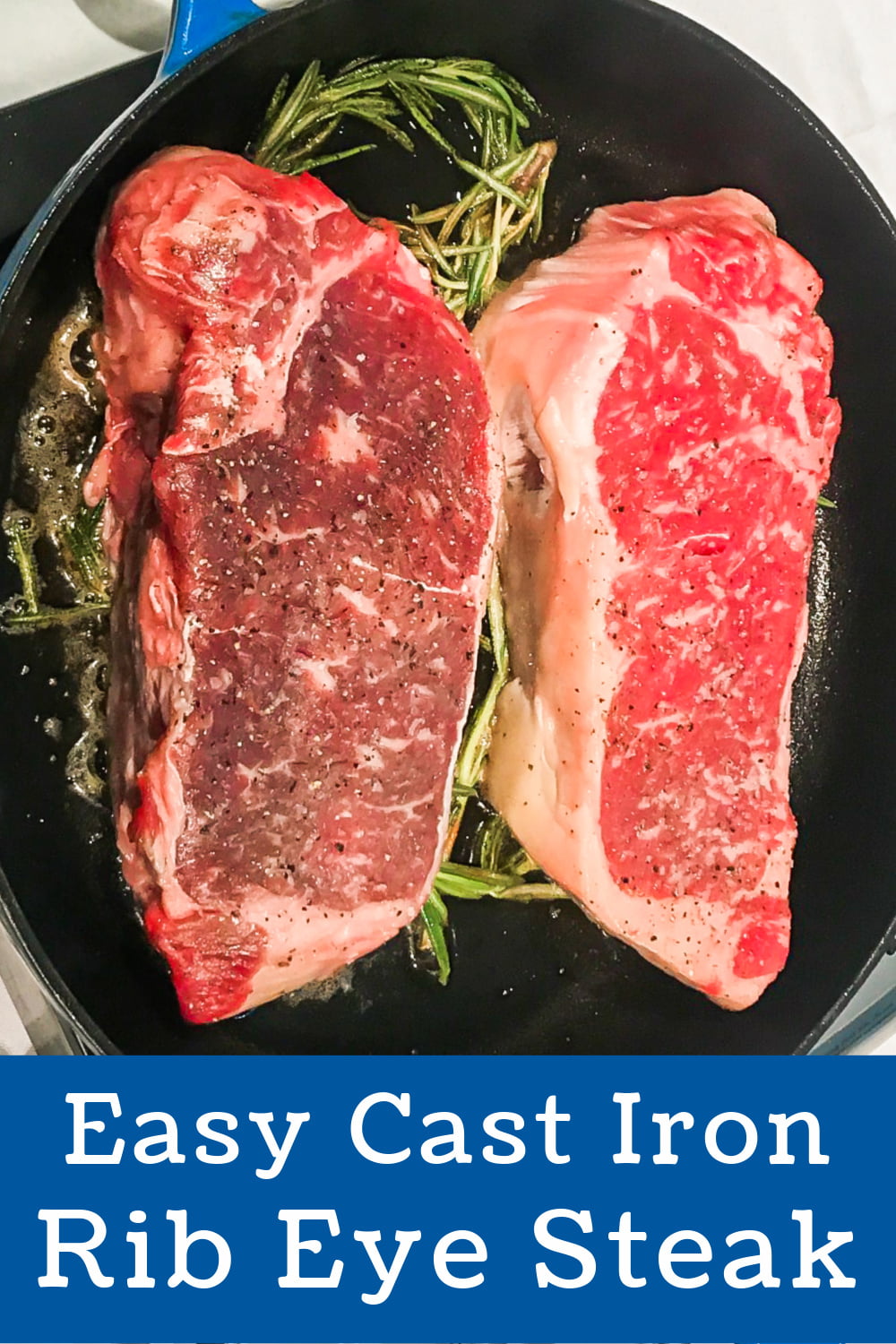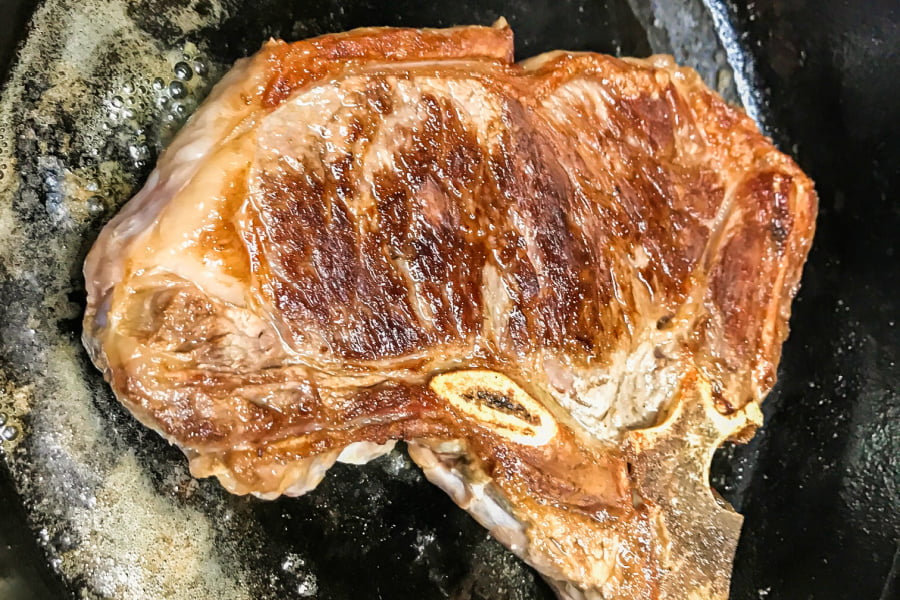Needing steak dinner ideas? I always do. Steak recipes are very popular in this household since I’ve got a bunch of carnivores that are hungry ALL the time. Juicy Cast Iron Skillet Steak is one of our favorites because the cast iron skillet cooking method guarantees a juicy, tender, medium-rare steak experience every single time.
Juicy Cast Iron Skillet Steak Recipe

Howdy! Chef Alli Here. Let’s Get You Cookin’….Shall We?? 
I’m a huge fan of cast iron cooking! A cast iron skillet is a life-time purchase that can be passed down through the generations.
As a matter of fact, it’s a good idea to be cooking with a cast iron skillet for each child that you have. As an example, if you have 3 children, you should be cooking with 3 cast iron skillets over the year.
Why? Well, because each of your children will want Mom’s cast iron skillet (or Dad’s cast iron skillet), this keeps them from fighting since they will each have one that you lovingly cooked from, seasoned, and took care of. Everybody’s happy!
3 good reasons to love this recipe –
- Perfectly tender and juicy medium-rare steak made right on your stove top.
- Cast iron cooking brings back good memories of my Grandma Lucille. She fried a lot of crappie in her cast iron skillet – so good.
- This cooking method proves you don’t have to have a grill or smoker to make a delicious steak.
What ingredients do you need to make Juicy Cast Iron Skillet Steak?
- Your favorite cut of steak – rib eye, t-bone, porterhouse, KC strip, etc.
- Kosher salt and freshly ground black pepper
- Unsalted butter
- Olive oil

How to Make Juicy Cast Iron Skillet Steak in 5 Easy Steps (Medium-Rare Doneness)
- Season the steak placing them, uncovered, into the fridge over night or for 8-10 hours.
- When you’re thinking about cooking the steaks, remove them from the fridge and let them rest on the counter, still uncovered, for 1-2 hours to remove the chill.
- Preheat the cast iron skillet over medium high heat; when the skillet is good and hot, add the fats. When the fats are sizzling, add the steak to the skillet, browning well on each side until nicely caramelized. Turn the heat to medium and continue to cook the steak to an internal temperature of 120 degrees F. as an internal temperature.
- Remove the skillet from the heat and cover it tightly with foil. Let the steak rest for 10 minutes so the internal temperature can raise to 135-140 for the perfect medium-rare doneness.
- Place the warm steak onto a large cutting board and slice across the grain into strips, as desired. Or, place whole steaks on to dinner plates and serve as is.
Common Questions Asked About
This Recipe
What is the secret to making juicy and tender cast iron skillet steak??
Here my 5 SECRET TIPS for assuring your steak cooks PERFECTLY every time:
- Always, always make sure that any steak (or any meat for that matter) has had plenty of beauty rest before you attempt to cook it. This is critical!!
- When meat chills, all the fats and juices coagulate at the center. If you remove the meat from the fridge and give it time on the counter to rest and let that chill remove itself, this will allow the meat fibers (protein fibers) to relax so all the fats and juices can move from the center of the meat to the edges where they belong.
- Beauty rest also ensures that you never slap a cold piece of meat onto a hot cooking surface! Ice cold meat can quickly cool off any cooking surface (whether skillet or grill) and that means you aren’t going to get that nice sear that you want for the caramelization process.
- And please don’t forget that meat needs beauty rest AFTER cooking as well. This 10 minute rest allows the meat to continue to raise in temperature from residual heat and also relaxes those protein fibers once more so you can easily slice the meat to serve it.
- Always slice meat across the grain, not with the grain. Slicing across the grain makes the protein fibers shorter so that the meat is always tender and provides a good eating experience.
What’s so great about a cast iron skillet anyway?
- I love cast iron for it’s great cooking properties! Cast iron provides even heat for cooking and has life-time durability. Most cast iron skillets get handed down again and again to upcoming generations of family – super cool.

- Because cast iron can handle high temperatures it sears meat wonderfully. Searing meat, most especially steaks, is what provides great caramelization on the exterior that really amps up the eating experience. Remember! When we cook, brown is not a COLOR, it’s a FLAVOR.
- Cast iron cookware is very versatile since it can go from the stovetop to the oven to the grill and back again.
- Lastly, because cast iron holds heat so well, I love being able remove dinner from the oven and place it right in the center of the table for everyone to serve themselves. It keeps dinner nice and hot!
- My favorite size of cast iron skillet is the 12-inch. I use the Lodge brand because it’s inexpensive (comparatively) yet wears very, very well. A 12-inch skillet is a standard size pretty and holds a lot of food. The sides are nice and deep, too.
Why does this recipe instruct to season the steaks and then put them in the fridge uncovered for several hours?
- Believe it or not, this step really helps the steaks (or any meat, actually) to get a good, crispy sear when you put them into the hot skillet. I was super skeptical about this technique until I tried it and I couldn’t believe the difference it made.
- Keep in mind that this step is totally optional – sometimes it hard to plan that far ahead. Know that you’ll still have delicious steaks even if you can’t do that step of this recipe. As long as you give the steak lots of beauty rest (before AND after!), don’t overcook it, and always slice across the grain, you’ll be very pleased.
What are the best steaks to cook in a cast iron skillet?
We enjoy a good T-Bone, Porterhouse, and KC Strip. However, our favorite steaks are rib-eyes. Yep, they do have a higher fat content than other steaks, but that fat helps make a very juicy and tender steak, for sure. They are good and meaty!

What Tools Are Good for Cooking Steak?
- Tongs are helpful for turning steaks when searing and cooking. I don’t like to use meat forks for steaks since every time you pierce the steak, you are losing those yummy juices!
- Lodge Cast Iron 12-inch skillet. This is a great size for cooking steaks since you can easily fit a large t-bone steak or a porterhouse steak in it. We usually eat rib eye steaks so it’s nice to be able to cook two of them side-by-side in my cast iron skillet.
- Instant-read meat thermometer…such an essential tool for cooking the perfect doneness of steak that you prefer. (Please tell me you like your steaks cooked to medium-rare!)
Why is beauty rest for steaks so important?
- When cooking any type of meat, beauty rest (resting time) is very, very important. Always do this step both before and after cooking the meat – it is essential, and most people don’t understand how or why.
- As meat chills, all the juices and fat coagulate at the center. The resting time before cooking or grilling allows the meat fibers (protein fibers) to relax and this lets all those juices and fats at the center of the meat redistribute themselves to the edges of the meat.
- Why does this matter? Well, for one thing the steak will cook much more evenly, receive the heat you are cooking with more easily, and since you aren’t slapping an ice-cold steak onto the grill or into a hot skillet, the steaks are able to get a really nice sear on the exterior.
Why does a good sear on the exterior of a steak matter so much?
- Searing a steak creates caramelization on the exterior of the steak, caused when you heat sugars and amino acids together. Caramelization is what causes that very tasty and delightful crusty surface that we all love. In my opinion, searing any kind of meat is essential, but most especially a STEAK.

What does cutting across the grain of steak mean? How do I do that?
- If you are going to slice the steak instead of serving it as a whole piece of meat on a dinner plate, you definitely need to slice it across the grain.
- First, place the cooked steak onto a large cutting board; find the direction of the grain by looking to see which way the muscle fibers are aligned. Now, slice across those muscle fibers (the grain) rather than parallel with the grain.
- Cutting through the muscle fibers, across the gain, shortens the them making the meat much easier to chew and enjoy.
- Slicing meat along the grain (instead of across the muscle fibers) leaves you with steak that’s much chewier.
Helpful Steak Doneness Temperatures –
Here’s a quick breakdown of internal temperatures to watch for the desired degree of doneness:
- Rare: 125 degrees F. – Has a cool red center
- Medium Rare: 135 degrees F. – has a warm dark pink center
- Medium: 145 degrees F. – has a warm pink center
- Medium Well: 150 degrees F. – very slightly pink center (not recommended!!)
- Well Done: 160 degrees F. – no pink at all (never recommended!!)

More Favorite Meat Recipes to Enjoy –
- HOW TO MAKE TENDER AND JUICY BEEF TRI TIP STEAK
- AIR FRYER MARINATED STEAK BITES
- SAVORY-SWEET BACON CHEESEBURGER SLIDERS
- EASY INSTANT POT SWISS STEAK
- COUNTRY FRIED STEAK FINGERS WITH LUMP-FREE CREAM GRAVY
- AIR FRYER BRATS WITH PEPPERS AND ONIONS
Here’s a helpful article on how to season a cast iron skillet!
Printable Juicy Cast Iron Skillet Steak Recipe –

Juicy Cast Iron Skillet Steak
Ingredients
- kosher salt and black pepper to taste
- 2 rib-eye steaks or 1 t-bone steak, about 1 1/2-inches thick we prefer rib-eye steaks or t-bone steaks
- 2 Tbs. unsalted butter
- 1 Tbs. olive oil
Instructions
- Please Note: The following recipe instructions are for cooking steak that has a final internal temperature of 135-140 degrees F. for medium-rare doneness. Pat each rib-eye steak dry with paper towels, then season each one well on both sides with kosher salt and freshly ground black pepper. Transfer the seasoned steaks to the cooling rack that has been placed over a rimmed baking sheet. Refrigerate the steaks, uncovered, for 8-10 hours. **Please Note: This step is optional, but it definitely helps the steaks form a really good exterior crust when seared in the cast iron skillet.
- 1-2 hours prior to when you want to cook the steaks, remove them from refrigeration to let them rest, still uncovered, on the kitchen counter. **Please Note: This resting time previous to cooking is essential for tender and juicy steaks! When the rib-eyes have had 1-2 hours of beauty rest on the counter, pat them dry with paper towels, then season each one once more with a sprinkling of kosher salt and freshly ground black pepper.
- Heat a 12-inch cast iron skillet over medium-high to high heat until almost smoking hot; add the oil and butter to the skillet at that point. When the fats are sizzling, add the steaks, side-by-side in the skillet but not touching each other, searing each one on both sides, approx. 1-2 minutes per side, until the exterior of each steak is deeply browned and crusty. **Don't play with the steaks when they are searing! Otherwise they can't brown nicely.
- Once the steaks are nicely seared on the exterior of both sides, turn the heat to medium, continuing to cook the steaks, until the internal temperatures reaches 120 degrees F. at the center of each steak when tested with an instant-read meat thermometer. Remove the skillet from the heat, covering it tightly with foil, letting the steaks rest for 10 additional minutes. **Please Note: This resting time after cooking is essential for tender and juicy steaks!! During this final 10 minutes of resting time, the steaks will continue to cook from residual heat, raising to the perfect medium-rare internal temperature of 135-140 degrees F.
- If you are slicing the steaks, place the rib-eyes onto a cutting board and slice across the grain into fat slices, or as preferred. Enjoy!
Notes
Tips for the Best Cast Iron Skillet Steak
- Start with a good quality steak. We prefer rib eye, t-bone, porterhouse, and KC strip
- Make sure you give the steak plenty of beauty rest before cooking it and 10 minutes after cooking it – this is ultra important!!
- Always preheat your cast iron skillet so the steak will get a nice sear when it’s hits the surface. Preheating should take just a couple of minutes and you want the butter and oil in the skillet to be shimmering, almost smoking.
- Dabbing the steaks dry with paper towels makes for a drier exterior which means you’ll get a more crispy sear to enjoy.
- Always use an instant read thermometer to test the internal temperature. No one wants an an overcooked (medium well) steak! And, using an instant read meat thermometer means you won’t have to cut into the steak to check the doneness – this wastes precious steak juices needlessly.
Nutrition
Thanks for visiting! I hope you return soon for more yummy recipes for your family.
We love hearing from our readers and followers, so leave us a comment if you’d like. If you don’t hear back from us shortly, know that we may not have seen your comment. Feel free to reach out to us by email: ChefAlli@ChefAlli.com.
Let’s Get You Cookin’,
Chef Alli
Please Note: We do use referral and affiliate links here for products and services that Chef Alli loves and recommends. I may receive a small compensation when you use these links. This really helps me keep my recipe blog moving forward. Thank you so much!
The post Juicy Cast Iron Skillet Steak appeared first on Chef Alli.
